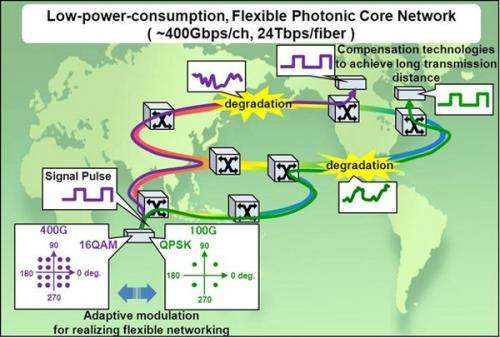400Gbps-class optical transmissions technology to deliver optical networks that are energy efficient, flexible

Fujitsu Limited, Nippon Telegraph and Telephone Corporation and NEC Corporation today announced the commencement of joint research and development toward making the world's top-level,400Gbps/channel-class digital coherent optical transmissions technology. Bringing together the technological capabilities that have enabled the commercialization of 100Gbps-class optical transmissions methods, which are becoming more prevalent among the world's optical networks, the companies will work to further enhance the performance and functionality of the digital coherent optical transmissions method, a key technology in optical transmissions.
This enables the possibility of realizing the world's top-level optical networks that combine ultra-high speeds, low energy consumption and flexibility, while also contributing to improvements in optical transmissions technology and the global spread of the research results. This R&D initiative was commissioned and is sponsored by Japan's Ministry of Internal Affairs and Communications (MIC) as part of the "Research and Development Project for the Ultra-high Speed and Green Photonic Networks" program.
"In 2012 the supply and demand of 100G products began to converge, leading to significant growth in deployments. The demand for network connectivity will only increase. Therefore, the need for 400G solutions that provide even greater bandwidth with the lowest possible power consumption and flexible, adaptive modulation will be critical," noted industry analyst Dana Cooperson, VP Network Infrastructure, Ovum, Inc. "Fujitsu, NTT and NEC's collaborative efforts to meet this growing demand illustrate what's possible when key industry players work together. Carriers, enterprises, governments, and others would be wise to look closely at this solution as they evolve their networks."
To accommodate the explosive growth in data communications traffic stemming from the spread of the Internet and smartphones in recent years, 100Gbps-class optical transmission methods are starting to become more practical. At the same time, with the arrival of the big data era, along with a surge in the diversity of data due to the spread of machine-to-machine communications, customer expectations with regard to speed and service continue to grow. Not only will data traffic in the near future grow at a rapid pace, but networks will also experience extremely large fluctuations in communications traffic, thereby resulting in a need to build flexible network infrastructure that can withstand such demand.
To address these impending challenges, core optical networks will require even greater speeds. With existing optical transmission technology, however, it is difficult to ensure the optical transmission performance needed to meet this demand for higher speeds. Moreover, existing communications equipment consumes a substantially higher amount of power in proportion to the amount of data transmitted. To enable high-capacity optical transmissions using relatively low power, a new optical transmissions solution is needed.
Building a flexible network architecture requires the ability to adapt, in real-time, to changes in data volumes and transmission distances. Therefore, great demand exists for the construction of highly flexible networks that can support regional differences in network architectures with a single core technology.
To meet these challenges, the three companies are aiming to build flexible, low-power networks in an effort to bring about a comfortable, eco-friendly society. As such, they are commencing research and development directed at implementing the core technologies required for these networks.
Fujitsu, NTT and NEC have pursued R&D on 100Gbps-class digital coherent optical communications technology as part of the MIC's "Research and Development on High Speed Optical Transport System Technologies" program (2009) and "Research and Development on Ultra-high Speed Optical Edge Node Technologies" program (2010-2011). The digital coherent DSP-LSI that was commercialized in 2012 as a result of these programs currently holds the world's top market share. Moreover, the achievements of these development initiatives are currently being deployed by each company as part of a global roll-out to optical networks throughout the world.
In order to once again leverage the three companies' technologies and teamwork to bring about even greater capacity optical transmissions with lower energy consumption, the companies will be working under the support of the MIC's "Research and Development Project for the Ultra-high Speed and Green Photonic Networks" to accelerate R&D on element technologies aimed at making practical 400Gbps-class optical transmissions.
The joint research will enable ultra-high-speed 400Gbps-class optical transmissions through the use of dual-polarization quadrature phase shift keying (DP-QPSK), which is currently in use for 100Gbps transmissions, together with dual-polarization 16 quadrature amplitude modulation (DP-16QAM), which takes advantage of an even greater number of quadrature carriers. By incorporating these modulation techniques into a high-density 60-channel fiber, the technology will be able to bring about the world's highest capacity optical networks capable of 24Tbps/fiber-class transmissions. In addition, to cut down on power consumption, long-haul transmission technology that can lead to reductions in the number of devices is required.
In light of this, the companies aim to provide the world's first compensation technology for nonlinear optical effects within an optical fiber—the primary limiting factor standing in the way of long-distance transmission of multiple quadrature modulated signals. When employed together with enhanced-performance versions of existing compensation technologies for chromatic dispersion and polarization mode dispersion, the new technology will achieve longer transmission distances. Furthermore, the companies will pursue the implementation of adaptive modulation/demodulation technology that can employ a host of modulation techniques depending on the transmission route using a single hardware device, thereby leading to the construction of flexible network architecture.
Through the new project, the companies will enable the following kinds of next-generation optical network capabilities by 2014:
- Ultra-high-speed and high-capacity optical transmissions – 400Gbps/channel-class and 24Tbps/fiber
- Compensation for chromatic dispersion, polarization mode dispersion and nonlinear effects occurring on a fiber-optic line, all of which are factors that lead to performance deterioration. This results in improved optical reach (greater than 2 times that of existing technologies).
- A substantial reduction in network power consumption (less than half of existing technologies) as a result of the need for fewer devices.
- The construction of flexible networks through adaptive modulation/demodulation using a single hardware device.
More information: www.ntt-electronics.com/new/in … tion/2012_02_29.html
Provided by Fujitsu


















